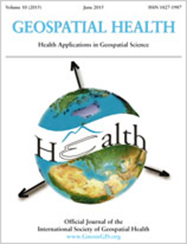Optimizing vaccination sites for infectious diseases based on heterogeneous travel modes in multiple scenarios

Published: 24 March 2025
Abstract Views: 856
PDF: 116
HTML: 1
HTML: 1
Publisher's note
All claims expressed in this article are solely those of the authors and do not necessarily represent those of their affiliated organizations, or those of the publisher, the editors and the reviewers. Any product that may be evaluated in this article or claim that may be made by its manufacturer is not guaranteed or endorsed by the publisher.
All claims expressed in this article are solely those of the authors and do not necessarily represent those of their affiliated organizations, or those of the publisher, the editors and the reviewers. Any product that may be evaluated in this article or claim that may be made by its manufacturer is not guaranteed or endorsed by the publisher.
Similar Articles
- Kwang-Soo Lee, Kyeong-Jun Moon, Hospital distribution in a metropolitan city: assessment by a geographical information system grid modelling approach , Geospatial Health: Vol. 8 No. 2 (2014)
- Andreja Kukec, Marija Z. Boznar, Primoz Mlakar, Bostjan Grasic, Andrej Herakovic, Vesna Zadnik, Lijana Zaletel-Kragelj, Jerneja Farkas, Ivan Erzen, Methodological approach to determine of small spatial units in a highly complex terrain in atmospheric pollution research: the case of Zasavje region in Slovenia , Geospatial Health: Vol. 8 No. 2 (2014)
- Rudi Cassini, Paolo Mulatti, Claudia Zanardello, Giulia Simonato, Manuela Signorini, Stefania Cazzin, Pier Giorgio Tambalo, Mario Cobianchi, Mario Pietrobelli, Gioia Capelli, Retrospective and spatial analysis tools for integrated surveillance of cystic echinococcosis and bovine cysticercosis in hypo-endemic areas , Geospatial Health: Vol. 8 No. 2 (2014)
- Wendelin Moser, Helena Greter, Christian Schindler, Fiona Allan, Bongo N. R. Ngandolo, Daugla D. Moto, Jürg Utzinger, Jakob Zinsstag, The spatial and seasonal distribution of Bulinus truncatus, Bulinus forskalii and Biomphalaria pfeifferi, the intermediate host snails of schistosomiasis, in N'Djamena, Chad , Geospatial Health: Vol. 9 No. 1 (2014)
- Manuela Signorini, Rudi Cassini, Michele Drigo, Antonio Frangipane di Regalbono, Mario Pietrobelli, Fabrizio Montarsi, Anna-Sofie Stensgaard, Ecological niche model of Phlebotomus perniciosus, the main vector of canine leishmaniasis in north-eastern Italy , Geospatial Health: Vol. 9 No. 1 (2014)
- Samuel F. Atkinson, Sahotra Sarkar, Aldo Aviña, Jim A. Schuermann, Phillip Williamson, A determination of the spatial concordance between Lyme disease incidence and habitat probability of its primary vector Ixodes scapularis (black-legged tick) , Geospatial Health: Vol. 9 No. 1 (2014)
- Naoko Nihei, Osamu Komagata, Kan-ichiro Mochizuki, Mutsuo Kobayashi, Geospatial analysis of invasion of the Asian tiger mosquito Aedes albopictus: competition with Aedes japonicus japonicus in its northern limit area in Japan , Geospatial Health: Vol. 8 No. 2 (2014)
- Hassan M. Khormi, Lalit Kumar, Climate change and the potential global distribution of Aedes aegypti: spatial modelling using geographical information system and CLIMEX , Geospatial Health: Vol. 8 No. 2 (2014)
- Romano Ngui, Aziz Shafie, Kek H. Chua, Mohd S. Mistam, Hesham M. Al-Mekhlafi, Wan W. W. Sulaiman, Rohela Mahmud, Yvonne A. L. Lim, Mapping and modelling the geographical distribution of soil-transmitted helminthiases in Peninsular Malaysia: implications for control approaches , Geospatial Health: Vol. 8 No. 2 (2014)
- Kuo-Hsin Tseng, Song Liang, Motomu Ibaraki, Hyongki Lee, C. K. Shum, Study of the variation of schistosomiasis risk in Lake Poyang in the People's Republic of China using multiple space-borne sensors for monitoring and modelling , Geospatial Health: Vol. 8 No. 2 (2014)
You may also start an advanced similarity search for this article.











